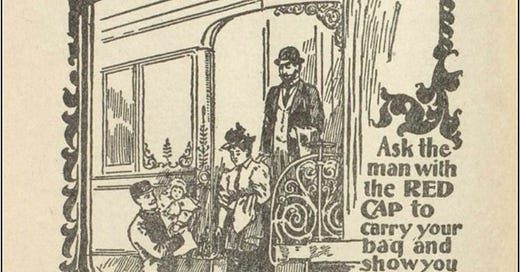Assisted with their baggage at Grand Central Station by an attendant in a red cap, a free service first advertised by the New York Central in 1896 (Harlow 408), the Austerlitz family headed to the busy streets jammed with street cars, hansom cabs, and beer trucks. Piling their luggage into a horse-drawn coach that charged $1.50 per hour and 25¢ for each piece of luggage (The Week in New York 30), they traveled 10 blocks south to 34th Street near what had been dubbed Herald Square in 1893 when the New York Herald moved from Manhattan’s “newspaper row” on Park Row to its new location on Broadway and 35th Street.
Just a few months before the family’s arrival in Manhattan, George M. Cohan had been singing “remember me to Herald Square” in his tune “Give My Regards to Broadway” in his first musical hit Little Johnny Jones (Nov. 7-Dec. 24, 1904 – Liberty Theatre 234 W. 42nd St.). The front page of Leslie’s Weekly on Sept. 8, 1904, had declared Herald Square the “liveliest section of New York’s business street.” When the Astaires arrived in 1905, this “liveliest section” of New York featured the world’s biggest hotel, the world’s biggest department store, a station of the world’s largest elevated railroad, and the printing press of the world’s biggest newspaper, the New York Herald.

The intersection was crowded with streetcars, horse drawn wagons and cabs, pedestrians scurrying to shops and offices, all in the shadows cast by the girders of the Sixth Avenue elevated train, which had been running between Trinity Place and 58th Street since 1879 (Fischler 258). One thing they wouldn’t have seen would have been the smoke and cinders spewing from the smokestacks of steam-powered Forney locomotives on the El, which had had been frightening horses, bothering pedestrians, and enraging merchants for nearly 25 years. Electric operation had begun on the Sixth Avenue line up to 58th Street on Oct. 1, 1902, and the last steam train ran on the Sixth Avenue El on April 4, 1903 (Fischler 256). By the middle of that year all steam-powered elevated passenger trains in Manhattan had been converted to electric operation (Sansone 5).
The Austerlitzes checked into the Herald Square Hotel at 118 W. 34th St. When the hotel had first opened on Sept. 27, 1899, it had 300 rooms and rates of $1.50 per day, and advertisements emphasized the building as “ABSOLUTELY FIREPROOF.” Concerns for safety may have been one of the reasons Fritz had picked that specific hotel, but it was more likely that he picked it for the hotel’s a-la-carte restaurant, its central location, and the growing fame of the neighborhood.

SOURCES
Fischler, Stan. Uptown, Downtown: A Trip Through Time on New York's Subways. New York: Hawthorn Books, 1976.
Harlow, Alvin. The Road of the Century: The Story of the New York Central. New York: Creative Age Press, 1947.
Sansone, Gene. New York Subways: An Illustrated History of New York City's Cars. Baltimore: The Johns Hopkins University Press, 1997.
The Week in New York 5 March 1905.








